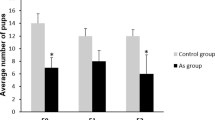Abstract
We have previously reported that inbred Wistar-Imamichi (WI) rats are highly resistant to cadmium (Cd)-induced testicular toxicity compared with inbred Fischer 344 (F344) rats. The present study was to elucidate the genetic background of resistance to Cd-induced testicular toxicity in WI rats. The genetic analysis of susceptibility to Cd-induced testicular toxicity was conducted by using Cd-resistant WI and Cd-sensitive F344 strains as the parental rats and by using the testicular hemoglobin level as the indicator. In the frequency distribution of testicular hemoglobin levels in parental, first filial (F1) and second filial (F2) rats treated with Cd at a dose of 2.0 mg/kg, F1 rats had testicular hemoglobin levels intermediate to WI and F344 rats, and F2 rats segregated into three groups of low, intermediate, and high phenotypes at the expected ratio. Furthermore, the backcross progeny between WI and F1 or between F344 and F1 segregated into two groups with the expected ratio. Based on a simple Mendelian genetic analysis, these segregation patterns lead us to conclude that two codominant alleles at a gene locus are responsible for the susceptibility to Cd-induced testicular toxicity in rats. This is the first report for the genetic analysis of susceptibility to Cd-induced testicular toxicity in inbred rat strains.



Similar content being viewed by others
References
Chellman GL, Shaikh ZA, Baggs RB, Diamond GL (1985) Resistance to cadmium-induced necrosis in testes of inbred mice: possible role of a metallothionein-like cadmium-binding protein. Toxicol Appl Pharmacol 79:511–523
Chen YC, Smith JB (1992) A putative lectin-binding receptor mediates cadmium-evoked calcium release. Toxicol Appl Pharmacol 117:249–256
Dalton TP, Miller ML, Wu X, Menon A, Cianciolo E, McKinnon RA, Smith PW, Robinson LJ, Nebert DW (2000) Refining the mouse chromosomal location of Cdm, the major gene associated with susceptibility to cadmium-induced testicular necrosis. Pharmacogenetics 10:141–151
Dalton TP, He L, Wang B, Miller ML, Jin L, Stringer KF, Chang X, Baxter CS, Nebert DW (2005) Identification of mouse SLC39A8 as the transporter responsible for cadmium-induced toxicity in the testis. Proc Natl Acad Sci USA 102:3401–3406
Elinder CG (1986) Cadmium and health. In: Friberg L, Elinder CG, Kjellstrom T, Nordberg GF (eds) A toxicological and epidemiological appraisal, vol 1. CRC Press, Boca Raton, pp 159–204
Glowinski IB, Weber WW (1982) Genetic regulation of aromatic amine N-acetylation in inbred mice. J Biol Chem 257:1424–1430
Goering PL, Waalkes MP, Klaassen CD (1994) Cadmium toxicity. In: Goyer RA, Cherian MG (eds) Handbook of experimental pharmacology: toxicology of metals. Biochemical effects. Springer, New York, pp 189–214
Gunn SA, Gould TC, Anderson WAD (1965) Protective effect of estrogen against vascular damage to the testis caused by cadmium. Proc Soc Exp Biol Med 119:901–905
He L, Wang B, Hay EB, Nebert DW (2009) Discovery of ZIP transporters that participate in cadmium damage to testis and kidney. Toxicol Appl Pharmacol 238:250–257
King LM, Banks WA, George WJ (1999) Differences in cadmium transport to the testis, epididymis, and brain in cadmium-sensitive and–resistant murine strains 129/J and A/J. J Pharmacol Exp Ther 289:825–830
Kojima S, Sugimura Y, Hirukawa H, Kiyozumi M, Shimada H, Funakoshi T (1992) Effects of dithiocarbamates on testicular toxicity in rats caused by acute exposure to cadmium. Toxicol Appl Pharmacol 116:24–29
Liu J, Corton C, Dix DJ, Liu Y, Waalkes MP, Klaassen CD (2001) Genetic background but not metallothionein phenotype dictates sensitivity to cadmium-induced testicular injury in mice. Toxicol Appl Pharmacol 176:1–9
Niewenhuis RJ, Prozialeck WC (1987) Calmodulin inhibitors protect against cadmium-induced testicular damage in mice. Biol Reprod 37:127–133
Shimada H, Narumi R, Nagano M, Yasutake A, Waalkes MP, Imamura Y (2009) Strain difference of cadmium-induced testicular toxicity in inbred Wistar-Imamichi and Fischer 344 rats. Arch Toxicol 83:647–652
Siu ER, Mruk DD, Porto CS, Cheng CY (2009) Cadmium-induced testicular injury. Toxicol Appl Pharmacol 238:240–249
Taylor BA, Heiniger HJ, Meier H (1973) Genetic analysis of resistance to cadmium-induced testicular damage. Proc Soc Exp Biol Med 143:629–633
Wang B, Schneider SN, Dragin N, Girijashanker K, Dalton TP, He L, Miller ML, Stringer KF, Soleimani M, Richardson DD, Nebert DW (2007) Enhanced cadmium-induced testicular necrosis and renal proximal tubule damage caused by gene-dose increase in a Slc39a8-transgenic mouse line. Am J Physiol Cell Physiol 292:C1523–C1535
Author information
Authors and Affiliations
Corresponding author
Rights and permissions
About this article
Cite this article
Shimada, H., Hata, I., Hashiguchi, T. et al. Genetic background of resistance to cadmium-induced testicular toxicity in inbred Wistar-Imamichi rats. Arch Toxicol 85, 1195–1199 (2011). https://doi.org/10.1007/s00204-011-0662-9
Received:
Accepted:
Published:
Issue Date:
DOI: https://doi.org/10.1007/s00204-011-0662-9




